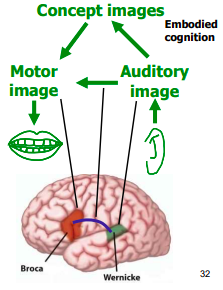From phrenology to scientific theory (week one)
0.0(0)
0.0(0)
Card Sorting
1/30
Earn XP
Description and Tags
Study Analytics
Name | Mastery | Learn | Test | Matching | Spaced |
|---|
No study sessions yet.
31 Terms
1
New cards
Who was Wilhelm Wundt and what did he do?
\~ first psychological laboratory (1879) in Leipzig
\
→ known for challenging 2500 old theory of association
\
→ known for challenging 2500 old theory of association
2
New cards
Who was Lightner Witmer?
\~ Wundt’ student who founded first psychological clinic (1896) and first journal The Psychological Clinic
3
New cards
Who was Mary Calkins? What is the technique of paired associates?
\~ first female president of APA
\
→ designed technique of paired associates \~ used to investigate episodic memory via syllable or word pairings (e.g. hot-complete, safe-green, …) → how does stimulus and response similarity affect transfer of learning
\
→ designed technique of paired associates \~ used to investigate episodic memory via syllable or word pairings (e.g. hot-complete, safe-green, …) → how does stimulus and response similarity affect transfer of learning
4
New cards
Who was Helen Thompson and what did she do?
\~ first person to perform studies on the differences between men and women (1910) with using experimental methods → contributed to the emancipation of women by proving that they are not inferior to men in thinking etc. (challenging the belief/norm that women didn’t belong to universities e.g.)
5
New cards
Who is William James and what is he known for?
\~ wrote Principles of Psychology (1890)
6
New cards
Who is Robert Woodsworth?
\~ wrote Experimental Psychology (1938) → “The Columbia Bible”
7
New cards
What pre-scientific theories are there?
a. associationism
b. connectionism
c. pseude-sciences
d. phrenology
b. connectionism
c. pseude-sciences
d. phrenology
8
New cards
What is asociationism?
\~ says that mental processes happen via associations in the brain
\
→ several senses that bring info to the mind where those are associated into a “common sense” that can then further be processed
\
Aristotle, Locke
\
\
→ several senses that bring info to the mind where those are associated into a “common sense” that can then further be processed
\
Aristotle, Locke
\
9
New cards
What are the principal associationist assumptions of John Locke and Aristotle?
**4 assumptions**
i. __blank slate/white paper__
ii. __sensoristic assumption__ \~ information comes in via senses thus all mental content is sensoristic in nature
iii. __atomistic assumption__ \~ sensory information serves as building blocks for more complex contents
iv. __associative assumption__ \~ association creates more complex content
i. __blank slate/white paper__
ii. __sensoristic assumption__ \~ information comes in via senses thus all mental content is sensoristic in nature
iii. __atomistic assumption__ \~ sensory information serves as building blocks for more complex contents
iv. __associative assumption__ \~ association creates more complex content
10
New cards
How does the law of contiguity work?
\~ when two things occur together often, association is formed (so that one of the things then reminds us of the other)
11
New cards
What is meant by long-term potentiation of Hebb?
\~ is the basis of the law of contiguity
\
→ fire together, wire together (nerve cells)
\
→ supported by discovery in 1973 in the hippocampus of rabbits when they found that long term potentiation strengthens synapses and makes them more efficient
\
→ fire together, wire together (nerve cells)
\
→ supported by discovery in 1973 in the hippocampus of rabbits when they found that long term potentiation strengthens synapses and makes them more efficient
12
New cards
What is connectionism about and who is associated with it?
\~ modern associationism → computer simulations/models are added
13
New cards
How are vertical and horizontal faculties different?
a. __horizontal/domain-general functions__
e.g. learning, memory, attention, perception, will
→ different senses and one common sense that operates regardless of the content of the individual senses
\
b. __vertical/domain-specific functions__
\~ came out of phrenology → specific mental functions tied to content, localised in the brain (on both sides the same)
→ when a domain is well developed, it becomes bigger, which could be observed on the skull as a bump (so they thought)
e.g. learning, memory, attention, perception, will
→ different senses and one common sense that operates regardless of the content of the individual senses
\
b. __vertical/domain-specific functions__
\~ came out of phrenology → specific mental functions tied to content, localised in the brain (on both sides the same)
→ when a domain is well developed, it becomes bigger, which could be observed on the skull as a bump (so they thought)
14
New cards
How did mesmerism, mental healing, spiritualism and physiognomy work?
a. __physiognomy__ \~ facial features (or more generally physical features) reflect people’s character (Lombroso, “criminal type”)
\
b. __mesmerism__ \~ healing at a distance either with magnets or more broadly via hypnosis
\
c. __mental healing__ \~ healing (mental) disorders by thinking correctly
\
d. __spiritualism__ \~ medium that connects with the spirits of the deceased
\
b. __mesmerism__ \~ healing at a distance either with magnets or more broadly via hypnosis
\
c. __mental healing__ \~ healing (mental) disorders by thinking correctly
\
d. __spiritualism__ \~ medium that connects with the spirits of the deceased
15
New cards
Who was Flourens and what did he do? How are holism and localisationism different?
__Flourens__ \~ cut out different parts of the brain of pigeons and rabbits to see what effect that has (brainstem → vital functions loss/death; cerebellum → loss of balance; cortex → higher mental fctions lost (not specified further)) => wasn’t able to find specific location for memory and perception (concluded that the holistic approach must be right)
\
__holism__ \~ functions distributed across the whole brain
\
__localisationism__ \~ specific functions have specific locations within the brain
\
→ experiments w/the brains of pigeons and rabbits not necessarily generalisable to humans
\
__holism__ \~ functions distributed across the whole brain
\
__localisationism__ \~ specific functions have specific locations within the brain
\
→ experiments w/the brains of pigeons and rabbits not necessarily generalisable to humans
16
New cards
What did Broca discover? Who was Mr. Tan? What did this mean for the controversy about the localisation of higher mental functions?
→ lesions/damage in the left inferior frontal cortex leads to problems w/speech production
\
Mr.Tan \~ patient who enabled this discovery, was only able to say tan
\
__meaning__ → supported the localisation hypothesis of mental functions in the brain
\
Mr.Tan \~ patient who enabled this discovery, was only able to say tan
\
__meaning__ → supported the localisation hypothesis of mental functions in the brain
17
New cards
What did Wernicke discover? What is the association theory of language? What are concept images?
\~ lesions in the specific part of the temporal lobe (wernicke’s area, posterior part of left superior temporal gyrus) lead to difficulty w/speech comprehension
\
**association theory of language**
- __wernicke’s area__ stores auditory images of words
- __broca’s area__ stores motor images of words
- general __concept image__ is stored/made in the cortex
- __fiber tract__ (arcuate fasciculus) connects broca’s and wernicke’s areas, allowing for associating those two images of words (and also for the reflexive repeating of words)
\
__concept images__
\~ associated sensory images of an object that a word refers to (e.g. colour, taste, shape, …) → __embodied cognition__ (the view that concepts consist of perceptual and motor features)
- are localised in different widely distributed areas of the brain (and then the info from all is brought together to create the full image)
\
**association theory of language**
- __wernicke’s area__ stores auditory images of words
- __broca’s area__ stores motor images of words
- general __concept image__ is stored/made in the cortex
- __fiber tract__ (arcuate fasciculus) connects broca’s and wernicke’s areas, allowing for associating those two images of words (and also for the reflexive repeating of words)
\
__concept images__
\~ associated sensory images of an object that a word refers to (e.g. colour, taste, shape, …) → __embodied cognition__ (the view that concepts consist of perceptual and motor features)
- are localised in different widely distributed areas of the brain (and then the info from all is brought together to create the full image)

18
New cards
How are Broca’s and Wernicke’s aphasia different?
__broca’s aphasia__ \~ difficulty or inability to produce speech, while comprehension is fairly intact
\
__wernicke’s aphasia__ \~ difficulty/inability to comprehend speech, while production is fairly intact
\
__conduction aphasia__ \~ repetition of speech impaired, while comprehension and production are fairly intact (it can still be repeated if it goes via the concept image, but the reflexive parroting of speech is imapaired)
\
__wernicke’s aphasia__ \~ difficulty/inability to comprehend speech, while production is fairly intact
\
__conduction aphasia__ \~ repetition of speech impaired, while comprehension and production are fairly intact (it can still be repeated if it goes via the concept image, but the reflexive parroting of speech is imapaired)
19
New cards
How was the speed of nerve impulses discovered/debated? How is it different from mental speed?
**Johannes Müller** thought that the speed of nerve transmission is infinite
\
**Hermann von Helmholtz** actually measured it in __frogs__ → 30 meters/second => was measured directly with the nerve stimulation and then the reaction closing off the electrical circuit (w/the dead frog’s nerve)
\
and later in __humans__ → 30 meters/second (he electrically stimulated people’s arms at different places and had them press a button when the felt it, but the measurements were much more varied than those w/frogs) => got to the 30 m/s by stimulating a direct finger response
\
__mental speed__ → **Donders** figured that the processing of stimuli takes time and measured it w/ the subtraction method (mental speed \~ the speed of the process in our mind after a stimulus before an output)
\
**Hermann von Helmholtz** actually measured it in __frogs__ → 30 meters/second => was measured directly with the nerve stimulation and then the reaction closing off the electrical circuit (w/the dead frog’s nerve)
\
and later in __humans__ → 30 meters/second (he electrically stimulated people’s arms at different places and had them press a button when the felt it, but the measurements were much more varied than those w/frogs) => got to the 30 m/s by stimulating a direct finger response
\
__mental speed__ → **Donders** figured that the processing of stimuli takes time and measured it w/ the subtraction method (mental speed \~ the speed of the process in our mind after a stimulus before an output)
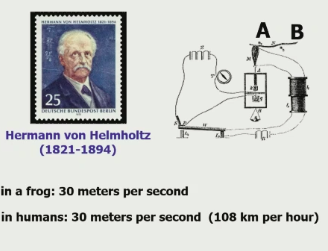
20
New cards
How does the Donder’s subtraction method work?
__**Task A**__
* simple reaction required (e.g. press a button as soon as a stimulus is presented)
* __mental stages involved__ → perception, action
\
__**Task B**__
* choice reaction is required (give an adequate response as soon as the stimulus is presented → e.g. left button for red, right button for green)
* __mental stages involved__ → perception, recognition (\~discrimination according to Donders), choice and action
\
__**Task C**__
* go/no-go reaction (respond/press a button only when a specific stimuli is presented, e.g. only when green dot appears)
* __mental stages involved__ →perception, recognition, action
\
**recognition duration** = task C - task A
**choice duration** = task B - task C
* simple reaction required (e.g. press a button as soon as a stimulus is presented)
* __mental stages involved__ → perception, action
\
__**Task B**__
* choice reaction is required (give an adequate response as soon as the stimulus is presented → e.g. left button for red, right button for green)
* __mental stages involved__ → perception, recognition (\~discrimination according to Donders), choice and action
\
__**Task C**__
* go/no-go reaction (respond/press a button only when a specific stimuli is presented, e.g. only when green dot appears)
* __mental stages involved__ →perception, recognition, action
\
**recognition duration** = task C - task A
**choice duration** = task B - task C

21
New cards
How does the additive factors method of Sternberg work?
\~ aims to identify specific mental stages of processing
\
clarity of stimulus should influence the duration of __perception stage__
\
number of responses should influence the duration of the __choice stage__
\
→ there is no interaction of these two (see the graph), the add onto each other, leading to overall higher response time (?)
\
clarity of stimulus should influence the duration of __perception stage__
\
number of responses should influence the duration of the __choice stage__
\
→ there is no interaction of these two (see the graph), the add onto each other, leading to overall higher response time (?)

22
New cards
What did Weber do?
was a psychophysicist and came up with the concept of *just noticeable differences* (in the pressure on the skin) *forming constant ratio*
* we don’t perceive the differences between things, but the ratio of the difference to the magnitude of that that is compared
\
deltaR/R = k
* we don’t perceive the differences between things, but the ratio of the difference to the magnitude of that that is compared
\
deltaR/R = k
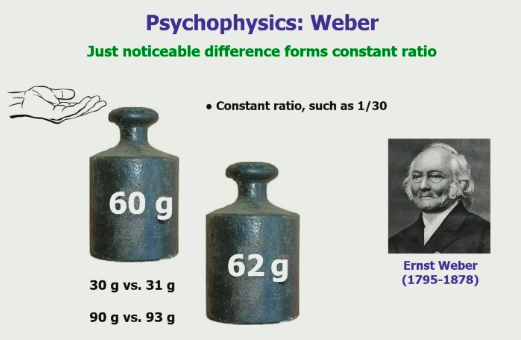
23
New cards
What is the logarithmic relation of physical and psychological quantities?
\~ **Fechner** realised that all just noticeable differences are subjectively equal → mathematically that is a logarithmic equation (between stimulus intensity and sensation) => __Fechner’s Law__ (S = k log R)
\
→ there is a difference between the psychological and physical differences in weight perception
\
__limen/liminal point__ \~ absolute lower threshold that stimulus needs to exceed to be perceivable
\
BUT if smth is too light it doesn’t mean that our brain cannot process the stimuli (e.g. we’d still see it ?)
\
→ there is a difference between the psychological and physical differences in weight perception
\
__limen/liminal point__ \~ absolute lower threshold that stimulus needs to exceed to be perceivable
\
BUT if smth is too light it doesn’t mean that our brain cannot process the stimuli (e.g. we’d still see it ?)
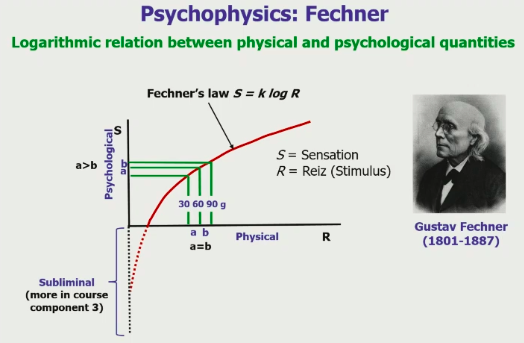
24
New cards
What is modularity of mind?
**Fodor** \~ combined Gall’s theories (localisationism) with Flourense’s (holism) → __mind__ is a system of localised modules and holistic central systems
\
__modules__ \~ domain specific/vertical faculties
\
__central systems__ \~ domain general/horizontal faculties
\
__modules__ \~ domain specific/vertical faculties
\
__central systems__ \~ domain general/horizontal faculties
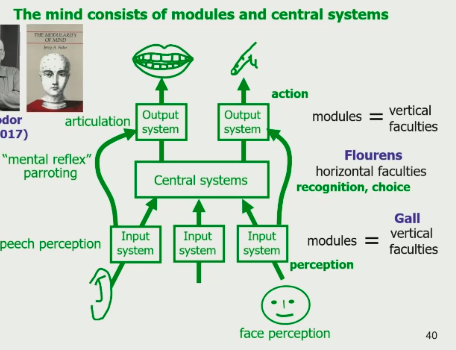
25
New cards
What are the 9 properties of modules? How is the central system different?
i. __domain-specific__ (processes a very specific thing e.g. doors but not planes)
ii. __mandatory__ (any stimulus that satisfies the basic properties will trigger it into action)
iii. __limited central access__ (output can be reported, but not the intermediate steps)
iv. __fast__ (happens instantly & w/o much effort)
v. __informationally encapsulated__ (knowledge is specific to that one thing this module processes)
vi. __shallow output__ (e.g. knowing we are seeing a face but not knowing who it is as that happens in the CS)
vii. __fixed neural architecture__ (located in a specific place in the brain)
viii. __specific breakdown patterns__ (specific impairment occurs when this system or its connection w/CS is damaged)
ix. __characteristic development__ (\~ ontogeny; specific pace and sequencing of development, present in babies and fully developed in adults)
\
CS → everything the modules are not (?)
ii. __mandatory__ (any stimulus that satisfies the basic properties will trigger it into action)
iii. __limited central access__ (output can be reported, but not the intermediate steps)
iv. __fast__ (happens instantly & w/o much effort)
v. __informationally encapsulated__ (knowledge is specific to that one thing this module processes)
vi. __shallow output__ (e.g. knowing we are seeing a face but not knowing who it is as that happens in the CS)
vii. __fixed neural architecture__ (located in a specific place in the brain)
viii. __specific breakdown patterns__ (specific impairment occurs when this system or its connection w/CS is damaged)
ix. __characteristic development__ (\~ ontogeny; specific pace and sequencing of development, present in babies and fully developed in adults)
\
CS → everything the modules are not (?)
26
New cards
Where is the fusiform face area and what is it responsible for? How is this different in children w/ASD?
\~ responsible for face recognition
\
__children/ppl w/ASD__ → face recognition is slower, fusiform area is smaller
\
__children/ppl w/ASD__ → face recognition is slower, fusiform area is smaller
27
New cards
What is prosopagnosia?
\~ __face blindness__ → inability to recognise faces and connect them w/a name e.g.
28
New cards
What does Nancy Kanwishner argue?
\~ that there are domain-general central systems that are however localised in the frontal and parietal parts of the brain
\
→ also, she says that there are modules for the perception of faces, places, visual words, body parts and assignment of thoughts to others (impaired in ASD)
\
→ also, she says that there are modules for the perception of faces, places, visual words, body parts and assignment of thoughts to others (impaired in ASD)
29
New cards
What are the 5 faculties of mind (horizontal)?
\~ learning, memory, attention, perception, will
30
New cards
What did Gall and Flourens disagree on? How did Flourens attempt to prove he is right?
\~ the debate between holism and localisationism
\
Gall was saying that functions were localised while Flourens concluded after his experiments w/animals (took away parts of their brains to see what happens) that functions are not localised
\
Gall was saying that functions were localised while Flourens concluded after his experiments w/animals (took away parts of their brains to see what happens) that functions are not localised
31
New cards
What are the main assumptions of Wernicke’s model? How does this explain the major aphasia types?
a. atomistic
b. sensoristic
c. associative
\
__Broca’s aphasia__ \~ when a person has difficulty or is not able to produce speech and repeat words they just heard (speech comprehension is intact) → explains it bc the motor image cannot be produced (?)
\
__Wernicke’s aphasia__ \~ when a person has difficulty or cannot comprehend speech and repeat words (speech production is relatively intact ) → explains this bc the auditory image doesn’t get processed therefore it cannot be passed onto the higher functions and processed/comprehended (?)
\
__Conduction aphasia__ \~ repetition of heard speech is impaired (comprehension and speech production are relatively intact) → because the two areas cannot communicate w/each other and therefore this is not possible via the easy route (could be done via the concept image, but thatś not the point of repeating heard speech we might not understand, e.g. foreign language)
\
\
b. sensoristic
c. associative
\
__Broca’s aphasia__ \~ when a person has difficulty or is not able to produce speech and repeat words they just heard (speech comprehension is intact) → explains it bc the motor image cannot be produced (?)
\
__Wernicke’s aphasia__ \~ when a person has difficulty or cannot comprehend speech and repeat words (speech production is relatively intact ) → explains this bc the auditory image doesn’t get processed therefore it cannot be passed onto the higher functions and processed/comprehended (?)
\
__Conduction aphasia__ \~ repetition of heard speech is impaired (comprehension and speech production are relatively intact) → because the two areas cannot communicate w/each other and therefore this is not possible via the easy route (could be done via the concept image, but thatś not the point of repeating heard speech we might not understand, e.g. foreign language)
\
\
